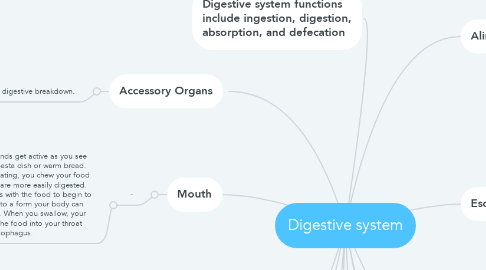Digestive system
by Hessa Abdulla


1. a 2-inch long canal consisting of the pelvic floor muscles and the two anal sphincters (internal and external). The lining of the upper anus is able to detect rectal contents. It lets you know whether the contents are liquid, gas or solid.
2. Accessory Organs
2.1. assists the process of digestive breakdown.
3. Digestive system functions include ingestion, digestion, absorption, and defecation
4. Mouth
4.1. -
4.1.1. Your salivary glands get active as you see and smell that pasta dish or warm bread. After you start eating, you chew your food into pieces that are more easily digested. Your saliva mixes with the food to begin to break it down into a form your body can absorb and use. When you swallow, your tongue passes the food into your throat and into your esophagus.
5. Small intestine
5.1. The duodenum is the first segment of the small intestine. It’s largely responsible for the continuous breaking-down process. The jejunum and ileum lower in the intestine are mainly responsible for absorption of nutrients into the bloodstream.
6. Liver
6.1. process the nutrients absorbed from the small intestine. Bile from the liver secreted into the small intestine also plays an important role in digesting fat and some vitamins.
7. Colon(large intestine)
7.1. responsible for processing waste so that emptying the bowels is easy and convenient. It’s a 6-foot long muscular tube that connects the small intestine to the rectum.
8. Anus
9. Esophegus
9.1. Located in your throat near your trachea (windpipe), the esophagus receives food from your mouth when you swallow. The epiglottis is a small flap that folds over your windpipe as you swallow to prevent you from choking (when food goes into your windpipe). A series of muscular contractions within the esophagus called peristalsis delivers food to your stomach.
10. Stomach
10.1. The stomach is a hollow organ, or "container," that holds food while it is being mixed with stomach enzymes. These enzymes continue the process of breaking down food into a usable form. Cells in the lining of the stomach secrete a strong acid and powerful enzymes that are responsible for the breakdown process. When the contents of the stomach are processed enough, they’re released into the small intestine.
11. Pancreas
11.1. -
11.1.1. The pancreas secretes digestive enzymes into the duodenum that break down protein, fats and carbohydrates. The pancreas also makes insulin, passing it directly into the bloodstream. Insulin is the chief hormone in your body for metabolizing sugar.

